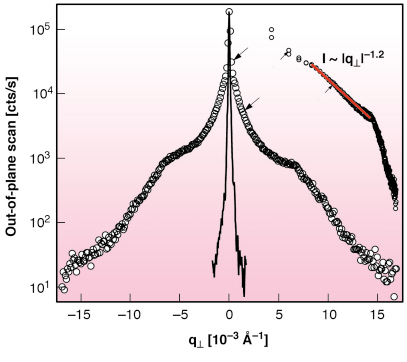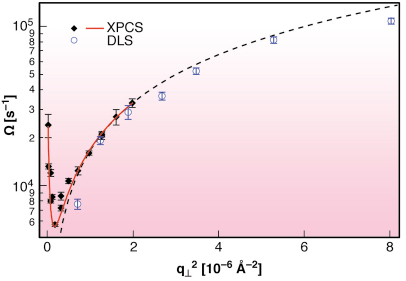- Home
- Users & Science
- Scientific Documentation
- ESRF Highlights
- ESRF Highlights 2006
- Soft Condensed Matter
- Dynamics of a lamellar phase studied by XPCS and dynamic light scattering
Dynamics of a lamellar phase studied by XPCS and dynamic light scattering
X-ray photon correlation spectroscopy (XPCS) is a relatively new technique, successfully used to study the dynamics of soft-matter systems. Conceptually, it is rather similar to the traditional dynamic light scattering (DLS) technique, but its main advantages with respect to DLS are the potential for reaching much higher scattering wave vectors and the fact that it is less affected by multiple scattering.
Smectic phases are amenable for study by XPCS, since their high degree of order confines the scattered signal in the vicinity of the Bragg peaks. In the present work we used XPCS to measure the dispersion relation of fluctuations in bulk samples of a lamellar lyotropic phase (exhibiting smectic symmetry) and compared the results with DLS measurements.
XPCS had never been applied to lamellar lyotropic phases. Although the symmetry is the same for thermotropic smectics, there are notable differences due to the two-component character of the lyotropic phase (leading to additional hydrodynamic modes), to its lower elastic moduli, which influence both the relaxation rates and the ‘spread’ of the diffuse scattering around the Bragg position (thus limiting the accessible wave vector range). The relaxation rate of the fluctuations is described by the elasticity of the phase and the associated dissipation coefficients (viscosities). We should therefore be able to determine these material constants, compare them with the values obtained by other methods and (as a next step) test the validity of the elasticity theory at high wave vectors.
The samples were prepared in flat glass capillaries and oriented by thermal cycling between the lamellar and the isotropic phases, resulting in very good homeotropic anchoring. The experiments were performed at ID10A using an X-ray energy of 13 keV, in the uniform filling mode of the storage ring. The scattered signal was detected by a fast avalanche photodiode (APD) and the output signal was processed online by a FLEX autocorrelator.
It is well known that bulk lamellar phases exhibit the Landau-Peierls instability, leading to a characteristic power-law variation of the scattered signal close to the Bragg peak (Figure 46), related to the product of the compression modulus of the lamellar phase B and the bending modulus of the bilayer, ![]() .
.
 |
|
Fig. 46: Out-of-plane scan of the first Bragg peak (open symbols) shown in log-lin and log-log (inset) representation. The scan of the primary beam is presented for comparison (solid line) scaled by a factor 10-4. In both graphs, the arrows indicate the range of the XPCS measurements. In the log-log graph, the straight line is the power-law fit to the intensity (see text). |
We recorded the time correlation function g(t) of the diffuse scattered signal, and analysed it to obtain the relaxation rate ![]() . The dispersion relation
. The dispersion relation ![]() (q) for fluctuations in the lamellar phase is described taking into account the finite size of the capillary. The fit quality is excellent (Figure 47) and, putting together the static and dynamic data, we determined the elastic moduli B and
(q) for fluctuations in the lamellar phase is described taking into account the finite size of the capillary. The fit quality is excellent (Figure 47) and, putting together the static and dynamic data, we determined the elastic moduli B and ![]() as well as the sliding viscosity of the phase
as well as the sliding viscosity of the phase ![]() 3; the results are in very good agreement with previously available data. We also checked our results against light scattering experiments: the relaxation rate measured in DLS agrees very well with the XPCS values (Figure 47).
3; the results are in very good agreement with previously available data. We also checked our results against light scattering experiments: the relaxation rate measured in DLS agrees very well with the XPCS values (Figure 47).
 |
|
Fig. 47: Comparison between the XPCS and DLS results. Diamonds and solid line: XPCS data and fit. Dotted line: fit extrapolation at high q. Open dots: DLS results. |
We have successfully demonstrated that the XPCS technique can be applied to the study of lamellar lyotropic phases. We measured the dispersion relation of the undulation mode in a lyotropic lamellar phase up to a wave vector qmax = 1.4 10-3 Å-1. Our results are in very good agreement with DLS measurements and comparable in terms of accessible range and accuracy. Combining XPCS and static data measured on the same sample using the same setup we obtained precise results for the material parameters of the lamellar phase. XPCS, therefore, complements and extends the range of DLS experiments.
Principal Publication and Authors
D. Constantin (a), G. Brotons (b), T. Salditt (c), É. Freyssingeas (d) and A. Madsen (e) Physical Review E 74, 031706 (2006).
(a) Laboratoire de Physique des Solides, Orsay (France)
(b) Laboratoire de Physique de l’État Condensé, Le Mans (France)
(c) Institut für Röntgenphysik, Göttingen (Germany)
(d) Laboratoire de Physique ENS-Lyon, Lyon (France)
(e) ESRF



